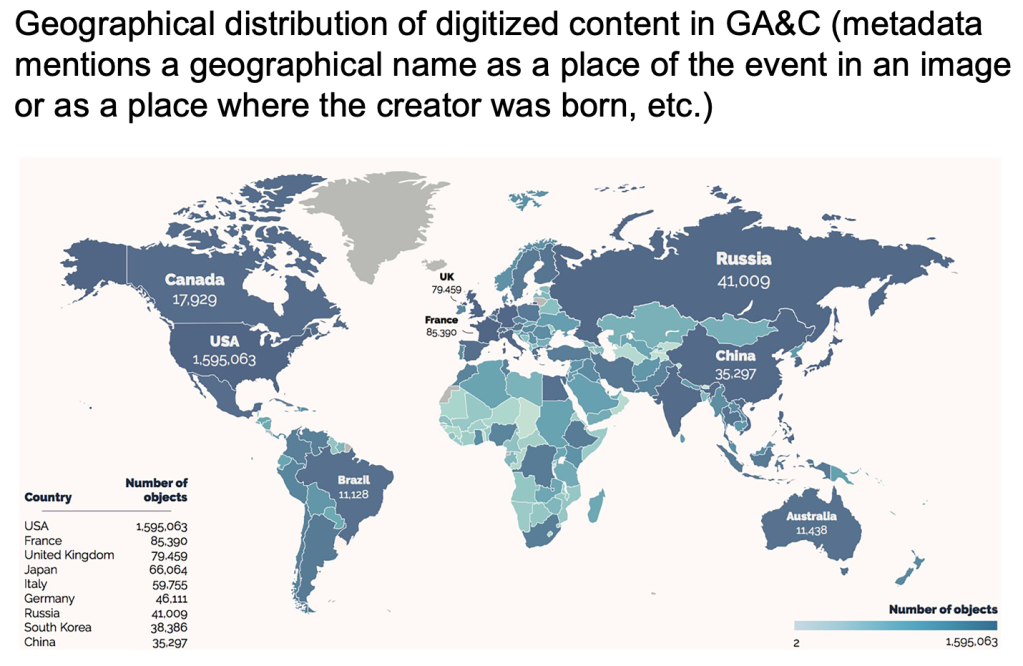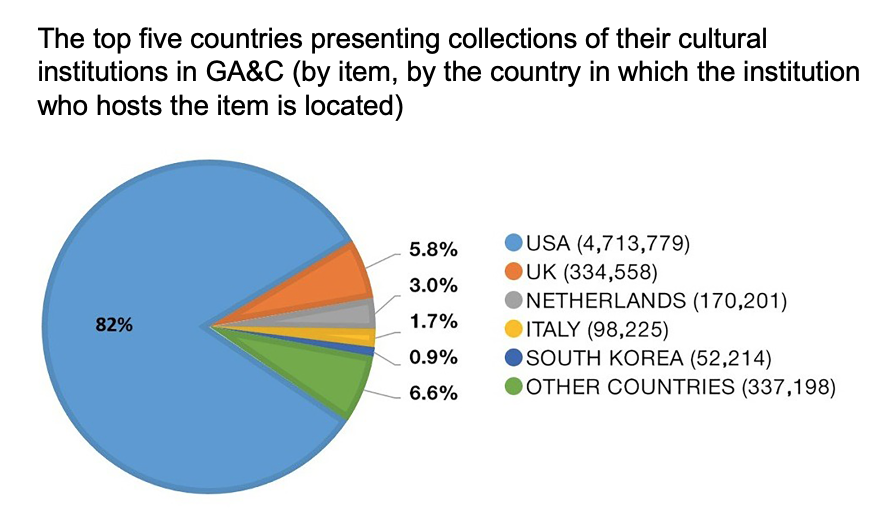
In February 2011, Google launched its Google Art Project, now known as Google Arts and Culture (GA&C), with an objective to make culture more accessible. The platform (and the content on its app) has dramatically grown since then, and currently hosts approximately six million high-resolution images of artworks from approximately 2,500 museums and galleries in almost every country featured in the UN member list. Although Google does not publish user statistics for the resource, it is understood that virtual visitor numbers increased dramatically during 2020, when many leading arts institutions had to close their doors because of the COVID-19 pandemic. There has, to date, been very little research published on the platform, and our newly published research in the Journal of Digital Scholarship in the Humanities (which was a Digital Humanities class project with Inna Kizhner‘s students at Siberian Federal University) interrogates GA&C to understand its scope, scale, and coverage.
Our scraping of the site content (in summer 2019) shows that Google Arts and Culture is far from a balanced representation of the world’s cultures:
- The major proportion of the holdings feature content that resides in the USA;
- Only 7.5% of the content is from institutions beyond the USA, UK, Netherlands and Italy;
- There are very few African cultural institutions who have contributed to the platform, and very little African culture present;
- The culture of some countries (such as Kazakhstan) are represented entirely by pictures of American and Russian culture via the space programme;
- Artworks from capital cities dominate the collections, while art from provinces is underrepresented;
- There is a dominance of art from the 20th century.

This leads to some extreme examples in the platform. There are next to no entries in GA&C featuring content originating in large parts of the African continent. American culture dominates Canadian culture. The culture of Kazakhstan (in 2019) was represented entirely in GA&C by 4000 pictures of American and Russian astronauts, from the NASA archives: no Kazakhstani institution had uploaded content themselves.
In 2016, Amit Sood, the Director of GA&C, 2016 claimed that it would introduce a new era of accessible art. However, we have shown that GA&C is a corpus where a number of cultures are underrepresented or marginalized. It maintains dominant cultural systems, including promoting the cultural holdings of the United States of America above all others. Google Arts and Culture is therefore an example of “digital cultural colonialism”, which amplifies the cultural holdings of one particular country, and also reinforces the conventional traditions of art collection and interpretation that dominate museum displays in larger Western cities.
The biases we have discovered in GA&C may have long-ranging affects. If larger quantities of objects, images, and stories related to a particular idea or representation of selected knowledge are present in aggregators of cultural content, these ideas and concepts will be promoted, accessed, disseminated, and studied, becoming the foundation of the new digital canon: one that can be appropriated for Artificial Intelligence and machine learning.
We argue that the choices that have gone into the content feature on GA&C should be made clear, as well as the biases contained within the platform. Our research is the first step to understand that this major platform is not neutral, and contains biases that will impact on its large user base, as well as data-led approaches that draw upon it, both now, and in the future. We end with a challenge: what will GA&C do to make its processes for ingesting and showcasing ‘arts and culture’ transparent, and how will it deploy its resources to expand the reach and spread of the digital content it features?
For more, see: “Digital cultural colonialism: measuring bias in aggregated digitized content held in Google Arts and Culture” by Inna Kizhner, Melissa Terras, Maxim Rumyantsev, Valentina Khokhlova, Elisaveta Demeshkova, Ivan Rudov, Julia Afanasieva. Digital Scholarship in the Humanities, https://doi.org/10.1093/llc/fqaa055.
Given that the copyright in DSH belongs to the authors, I’ve placed a copy of the journal article here on this blog, for easy and open access.
We are following up this research on the platform with a follow up study to understand the GLAM sector’s views on Google Arts and Culture, including the process of becoming a partner in the platform. If you would like to give your anonymous opinion, our online survey is open until 15th February 2021: we would appreciate all insights.

Hi!
I was directed to your site as the result of someone in my profession forwarding your survey. In all honesty, I think I discovered the Google Arts and Culture site quite some time ago, but have not used it until today.
My research into street names in my town delivered a reference to GAC – perhaps because Google recorded that I had visited the site only a few hours before.
To the point of my message: the description which appeared beneath the webpage title on the Google results screen actually bore no resemblance to the contents of the webpage, which was described as follows: “Sir Edward Travis, Director GCHQ, wrote to Welchman to praise and thank him for his wartime codebreaking work.” However, the letter in question which was displayed on the webpage said nothing of the sort. The letter uses such phrases as: “great shock … when you published your book… without consulting us and in defiance …”; “damage to security …”; “knock-on effect…” and so on.
See: https://artsandculture.google.com/asset/letter-from-sir-edward-travis-director-gchq/HwGmPd0UpsxDhQ?hl=en&ms=%7B%22x%22%3A0.5083784833655464%2C%22y%22%3A0.4649601767987745%2C%22z%22%3A9%2C%22size%22%3A%7B%22width%22%3A1.6762225969645868%2C%22height%22%3A0.7267303102625299%7D%7D
If this is the quality of Google’s resource description, then I really don’t think I shall be returning to look at further resources on the site!
Thank you for listening,
LikeLike